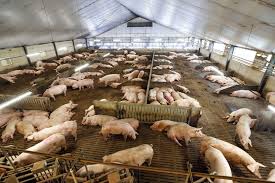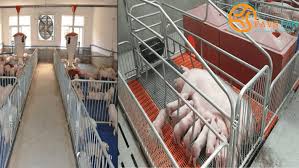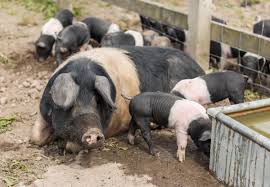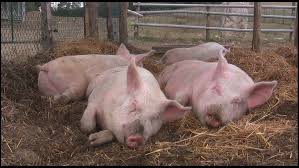Starting a piggery project can be a rewarding venture, whether you are looking to run a small-scale farm or aiming for a more commercial operation. Pigs are relatively easy to manage and can provide a good return on investment due to their fast growth rates and the rising demand for pork products.
However, like any livestock business, a piggery project requires careful planning, proper management, and knowledge about pig husbandry to succeed.
To begin, it is essential to assess the feasibility of starting a piggery in your area. Consider factors such as local demand for pork, availability of feed, veterinary services, and regulations concerning animal farming.
A thorough market study can help you identify the best approach, whether it’s breeding pigs for sale, raising pigs for pork production, or a combination of both.
Next, choose a suitable location for your piggery. The site should be spacious, well-drained, and away from residential areas to minimize odor issues and avoid disturbing neighbors. Pigs are adaptable, but they require a clean, dry environment to thrive.
Adequate space for housing, feeding, and waste management is necessary to maintain healthy pigs and ensure smooth operations. Additionally, consider the climate of your region, as extreme weather conditions can affect the pigs’ health and growth.
Once you’ve secured a location, focus on constructing pigpens. A well-designed pigpen should have proper ventilation, sufficient lighting, and protection from harsh weather.
It is also important to separate pigs according to their age, size, and purpose (breeding, fattening, etc.) to reduce overcrowding and competition for food.
The selection of pig breeds plays a crucial role in your piggery’s success. Choose breeds that are well-suited to your environment and farming goals. Popular breeds for commercial pig farming include Landrace, Large White, Duroc, and Hampshire.
Each breed has its strengths, such as faster growth, good meat quality, or higher litter sizes. It’s also important to source healthy piglets from reputable breeders to avoid introducing diseases to your farm.
Feeding is another critical aspect of running a successful piggery project. Pigs require a balanced diet rich in protein, energy, vitamins, and minerals to grow efficiently.
You can either formulate your own feed using locally available ingredients or purchase commercial pig feed. Access to clean water is also vital, as pigs consume large amounts of water daily.
Additionally, proper health care is essential to prevent diseases and maintain a healthy herd. Regular vaccinations, deworming, and proper sanitation practices will help reduce the risk of infections. You should also have a reliable veterinarian on hand for any emergencies or health concerns.
Planning Your Piggery Project

1. Conducting Market Research: Before starting your piggery project, it’s crucial to understand the local market demand for pork and pig products. Identify potential buyers, market trends, and competitors in your area. This helps ensure your piggery will be profitable.
2. Developing a Business Plan: Outline your goals, projected costs, expected income, and timelines for your piggery. Include details on how many pigs you plan to raise, how much land you’ll need, feed costs, veterinary expenses, and marketing strategies. A solid business plan is essential for guiding your project and securing financial backing if needed.
3. Choosing a Suitable Location: Select a site for your piggery that is spacious, well-ventilated, and far from residential areas to minimize the impact of odor and waste. The location should also have good drainage to avoid waterlogging and provide access to clean water and electricity for efficient operation.
4. Securing Legal Permits and Approvals: Ensure you comply with local regulations on animal farming by obtaining the necessary permits and approvals from agricultural or livestock authorities. This is vital for running a legal and sustainable piggery operation.
Selecting the Right Pig Breeds for Your Piggery Project
1. Understanding Breed Characteristics: Different pig breeds have varying traits such as growth rate, feed efficiency, disease resistance, and meat quality. Consider these factors when selecting breeds. Popular breeds include Yorkshire, Landrace, Duroc, and Berkshire, each known for specific qualities like fast growth or high-quality pork.
2. Purpose of Production: Decide whether your piggery will focus on breeding pigs for sale, meat production, or both. Some breeds are more suited for specific purposes, so selecting the right breed based on your production goals is crucial for maximizing efficiency and profitability.
3. Crossbreeding for Better Performance: Many pig farmers use crossbreeding techniques to improve the overall performance of their pigs. Crossbreeding combines the strengths of two or more breeds, resulting in piglets that grow faster, are more disease-resistant, and produce high-quality pork.
4. Source Healthy Piglets: Ensure that you acquire your piglets from reputable breeders to avoid health issues. Always check that the piglets are vaccinated and free from disease, as this will reduce the risk of infections spreading through your herd.
Read Also: 17 Medicinal Health Benefits of Campeche Basil (Ocimum campechianum)
Designing and Building Pig Pens for Your Piggery Project

1. Adequate Space for Growth: Design your pig pens with enough room for your pigs to move around comfortably. Overcrowding can lead to stress, fighting, and slower growth. A standard recommendation is to allow 8 to 10 square meters per adult pig to ensure proper space for feeding, resting, and moving.
2. Ventilation and Temperature Control: Pigs are sensitive to temperature, so your pens should be well-ventilated to keep the air fresh and control humidity. In warm climates, consider installing fans or ventilation systems, while colder climates may require heating elements to maintain an optimal environment.
3. Durable Flooring and Drainage Systems: Use concrete or slatted floors in your pens to provide a durable, easy-to-clean surface. Install proper drainage to prevent water from pooling in the pens, as standing water can attract parasites and bacteria, leading to disease outbreaks.
4. Feeding and Watering Systems: Equip your pens with easy-to-access feeding troughs and automatic waterers to ensure your pigs have a constant supply of food and water. This reduces labor costs and helps maintain hygiene by preventing feed or water spillage that could attract pests.
5. Safety Features: Ensure that the pens have sturdy fencing and gates to prevent pigs from escaping. Pens should also be designed to allow safe and easy access for workers, minimizing the risk of injuries when handling or treating pigs.
Feeding and Nutrition Management in Your Piggery Project
1. Balanced Diet Formulation: A well-balanced diet is crucial for the growth and health of pigs. It should include a mix of carbohydrates, proteins, fats, vitamins, and minerals. Common feed ingredients include corn, soybean meal, wheat, and various supplements. Consulting with a nutritionist can help formulate a diet that meets the specific needs of your pigs at different growth stages.
2. Age-Appropriate Feeding: Pigs have different nutritional requirements depending on their age. Piglets need a nutrient-rich starter feed that supports rapid growth, while growing pigs and finishing pigs require feeds that promote muscle development and weight gain. Adjust the diet based on the pig’s growth stage for optimal results.
3. Regular Feeding Schedule: Establish a consistent feeding routine to ensure pigs receive their daily intake of nutrients. Pigs thrive on routine, which can help improve their overall feeding efficiency. Divide their daily feed allowance into two or more meals to enhance digestion and reduce waste.
4. Monitoring Feed Intake: Keep track of how much feed each pig consumes to identify any changes in appetite or health. Uneaten feed may indicate underlying health issues or discomfort, prompting further investigation and necessary action.
5. Use of Supplements: Consider adding supplements to enhance the nutritional profile of the feed. This can include vitamins, minerals, probiotics, and enzymes, which can improve feed efficiency, promote gut health, and boost immunity.
Read Also: Forms of Phosphorus in Soil and Phosphorus Deficiency and Toxicity
Water Management in Your Piggery Project

1. Providing Clean Water: Fresh and clean water is vital for the health and growth of pigs. Ensure that water sources are regularly cleaned and maintained to prevent contamination, which can lead to disease outbreaks.
2. Adequate Water Supply: Pigs require a significant amount of water, especially during warmer months. Provide sufficient water access by using automatic waterers or troughs that can accommodate all pigs in the pen, ensuring they have constant access to hydration.
3. Temperature Control: Monitor the temperature of the water supply, as pigs prefer cool water, particularly in hot weather. If possible, install shaded or insulated water troughs to keep water at a comfortable temperature, encouraging greater water intake.
4. Regular Monitoring: Regularly check water intake levels to identify any changes in consumption, which could indicate health problems. Decreased water intake may signal illness or discomfort, prompting further investigation.
5. Water Quality Testing: Conduct periodic tests on water quality to ensure it meets safety standards. Look for contaminants such as bacteria, chemicals, and heavy metals that could harm your pigs. Treat or filter water as needed to maintain high quality.
Breeding Management in Your Piggery Project
1. Selecting Breeding Stock: Choose healthy and genetically superior breeding stock to improve the quality of your piglets. Consider traits such as growth rate, feed efficiency, and disease resistance when selecting sows and boars.
2. Understanding Estrus Cycle: Familiarize yourself with the estrus cycle of sows to optimize breeding times. Sows typically come into heat every 21 days, and recognizing signs of heat will help you time breeding accurately for successful conception.
3. Artificial Insemination vs. Natural Breeding: Decide whether to use artificial insemination or natural breeding. Artificial insemination allows for better genetic selection and can reduce the risk of disease transmission, while natural breeding may be more straightforward for some farmers.
4. Gestation and Farrowing Management: Monitor pregnant sows closely throughout gestation and provide proper nutrition to support fetal development. Create a comfortable farrowing environment with clean bedding, sufficient space, and minimal stress to ensure successful delivery and healthy piglets.
5. Record Keeping: Maintain accurate records of breeding dates, litter sizes, and piglet health. This data is invaluable for tracking the performance of your breeding stock and making informed decisions for future breeding programs.
Health and Disease Control in Your Piggery Project

1. Establishing a Health Management Plan: Create a comprehensive health management plan that outlines vaccination schedules, deworming protocols, and disease prevention strategies. This plan should be tailored to your specific piggery operation and local disease risks.
2. Regular Veterinary Care: Schedule regular check-ups with a qualified veterinarian to monitor the health of your pigs. Early detection of health issues can prevent outbreaks and reduce losses in your herd.
3. Vaccination Programs: Implement an effective vaccination program based on local disease threats. Common vaccinations may include those for swine flu, erysipelas, and leptospirosis. Vaccinating at the appropriate times can significantly reduce the risk of disease.
4. Biosecurity Measures: Practice strict biosecurity protocols to prevent disease transmission. This includes controlling access to your piggery, sanitizing equipment, and isolating sick animals from the rest of the herd.
5. Monitoring for Signs of Illness: Regularly observe your pigs for signs of illness, such as coughing, lethargy, loss of appetite, or abnormal behavior. Quick identification and response to health issues can mitigate the spread of disease and improve recovery outcomes.
Record Keeping for Your Piggery Project
1. Importance of Record Keeping: Maintaining accurate records is essential for the successful management of your piggery project. It helps track the performance of individual pigs, monitor breeding and health history, and evaluate financial performance, allowing for informed decision-making.
2. Types of Records to Maintain: Keep comprehensive records that include breeding dates, farrowing details, piglet health status, growth rates, feed consumption, and expenses. Other important records include vaccination schedules, treatments administered, and sales data for both live pigs and pork products.
3. Utilizing Software Solutions: Consider using farm management software to streamline record keeping. These digital tools can help organize data, generate reports, and simplify the tracking of various aspects of your piggery, making it easier to analyze trends and make adjustments.
4. Regular Updates: Ensure that records are updated regularly, ideally on a daily or weekly basis, to maintain accuracy. Assign a specific time each week to review and input data, ensuring that nothing is overlooked.
5. Reviewing Records Periodically: Regularly review your records to identify trends and areas for improvement. Analyzing data can help you make informed decisions regarding breeding, feeding, and overall herd management, ultimately leading to better productivity and profitability.
Marketing Strategies for Your Piggery Project
1. Identifying Your Target Market: Understand who your potential customers are, whether they are individual consumers, restaurants, or retailers. Researching the preferences and buying habits of your target audience will help tailor your marketing strategies effectively.
2. Creating a Brand Identity: Develop a strong brand identity that reflects the quality and uniqueness of your products. This includes designing an appealing logo, packaging, and promotional materials that convey your brand message.
3. Utilizing Social Media: Leverage social media platforms like Facebook, Instagram, and Twitter to connect with customers and promote your products. Share engaging content, such as farm updates, recipes, and customer testimonials, to build a loyal following.
4. Participating in Local Markets and Fairs: Get involved in local farmers’ markets, food fairs, and community events to showcase your pigs and pork products. Direct engagement with consumers can foster trust and brand loyalty while providing an opportunity for sales.
5. Building Relationships with Retailers and Chefs: Establish partnerships with local grocery stores, restaurants, and chefs who prioritize high-quality, locally sourced meat. Offering samples and engaging in collaborations can increase product visibility and sales.
Financial Planning and Budgeting for Your Piggery Project
1. Creating a Detailed Business Plan: A comprehensive business plan is the foundation of your piggery project’s financial management. Outline your goals, target market, production plans, and budget estimates, which will help guide your financial decisions.
2. Estimating Initial Costs: Calculate the initial costs involved in starting your piggery, including land acquisition, housing, equipment, breeding stock, and feed. Understanding these expenses will help you determine how much capital you need to get started.
3. Ongoing Expenses Management: Regularly monitor ongoing expenses, such as feed, veterinary care, labor, and utilities. Keeping track of these costs will allow you to manage cash flow effectively and identify areas for cost reduction.
4. Profitability Analysis: Conduct regular profitability analyses to evaluate the financial health of your piggery. This involves comparing your income from pig sales and other revenue sources against your total expenses, helping you make informed financial decisions.
5. Seeking Financial Assistance: Explore options for financial assistance, such as loans, grants, or subsidies available for agricultural projects. Having a solid financial plan in place will make it easier to secure funding when needed.
Challenges and Solutions in Running a Piggery Project
1. Disease Management: Disease outbreaks can significantly impact your piggery’s productivity and profitability. Implement strict biosecurity measures, vaccination programs, and regular veterinary checks to minimize disease risks and maintain herd health.
2. Market Fluctuations: The pork market can be volatile, with prices varying based on demand and supply. Diversifying your product offerings and exploring different sales channels can help stabilize income and reduce reliance on a single market.
3. Nutritional Management: Ensuring that pigs receive a balanced diet is crucial for their growth and health. Regularly consult with a nutritionist to adjust feed formulations based on the pigs’ changing needs and monitor feed quality to ensure optimal nutrition.
4. Labor Shortages: Finding skilled labor can be a challenge in pig farming. Provide training and create a supportive work environment to retain staff. Additionally, consider investing in automation for repetitive tasks to reduce labor demands.
5. Environmental Concerns: Waste management and environmental sustainability are crucial in pig farming. Implement effective waste management practices, such as composting and anaerobic digestion, to minimize environmental impact and comply with regulations.
Do you have any questions, suggestions, or contributions? If so, please feel free to use the comment box below to share your thoughts. We also encourage you to kindly share this information with others who might benefit from it. Since we can’t reach everyone at once, we truly appreciate your help in spreading the word. Thank you so much for your support and for sharing!
Read Also: The Impact of Inhaler Disposal on Our Environment
Frequently Asked Questions
We will update this section soon.

